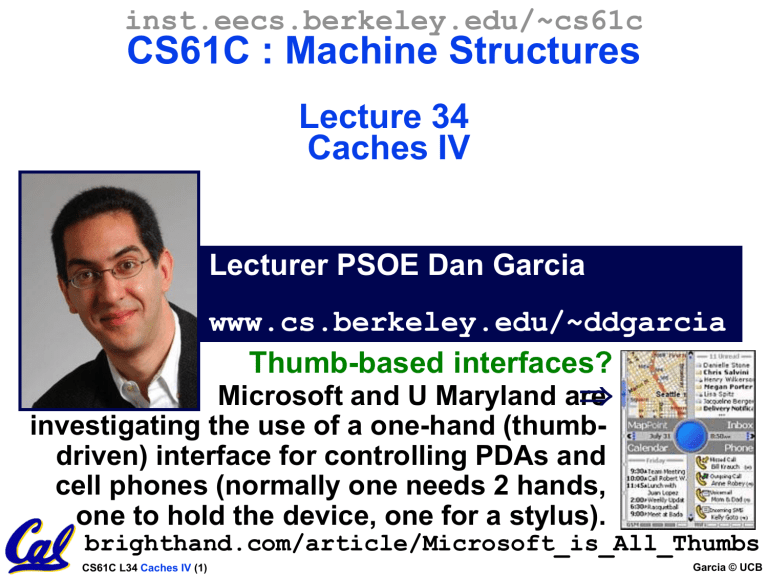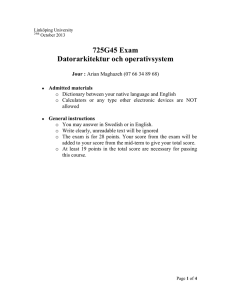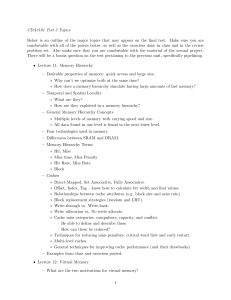CS61C : Machine Structures Lecture 34 Caches IV

inst.eecs.berkeley.edu/~cs61c
CS61C : Machine Structures
Lecture 34
Caches IV
Lecturer PSOE Dan Garcia www.cs.berkeley.edu/~ddgarcia
Thumb-based interfaces? investigating the use of a one-hand (thumbdriven) interface for controlling PDAs and cell phones (normally one needs 2 hands, one to hold the device, one for a stylus). brighthand.com/article/Microsoft_is_All_Thumbs
Garcia © UCB CS61C L34 Caches IV (1)
Review: Why We Use Caches
1000
100
10
CPU
µProc
60%/yr.
“Moore’s Law”
Processor-Memory
Performance Gap:
(grows 50% / year)
DRAM
DRAM
7%/yr.
1
• 1989 first Intel CPU with cache on chip
• 1998 Pentium III has two levels of cache on chip
Garcia © UCB CS61C L34 Caches IV (2)
N-Way Set Associative Cache (1/4)
• Memory address fields:
• Tag: same as before
• Offset: same as before
• Index: points us to the correct “row”
(called a set in this case)
• So what’s the difference?
• each set contains multiple blocks
• once we’ve found correct set, must compare with all tags in that set to find our data
CS61C L34 Caches IV (3) Garcia © UCB
N-Way Set Associative Cache (2/4)
• Summary:
• cache is direct-mapped w/respect to sets
• each set is fully associative
• basically N direct-mapped caches working in parallel: each has its own valid bit and data
Garcia © UCB CS61C L34 Caches IV (4)
N-Way Set Associative Cache (3/4)
• Given memory address:
• Find correct set using Index value.
• Compare Tag with all Tag values in the determined set.
• If a match occurs, hit!, otherwise a miss.
• Finally, use the offset field as usual to find the desired data within the block.
Garcia © UCB CS61C L34 Caches IV (5)
N-Way Set Associative Cache (4/4)
• What’s so great about this?
• even a 2-way set assoc cache avoids a lot of conflict misses
• hardware cost isn’t that bad: only need N comparators
• In fact, for a cache with M blocks,
• it’s Direct-Mapped if it’s 1-way set assoc
• it’s Fully Assoc if it’s M-way set assoc
• so these two are just special cases of the more general set associative design
Garcia © UCB CS61C L34 Caches IV (6)
Associative Cache Example
Memory
Address Memory
C
D
E
F
8
9
A
B
6
7
4
5
2
3
0
1
CS61C L34 Caches IV (7)
•
•
Cache
Index
0
1
2
3
4 Byte Direct
Mapped Cache
Recall this is how a simple direct mapped cache looked.
This is also a 1-way associative cache!
set-
Garcia © UCB
Associative Cache Example
Memory
Address Memory
C
D
E
F
8
9
A
B
6
7
4
5
2
3
0
1
CS61C L34 Caches IV (8)
•
Cache
Index
0
0
1
1
Here’s a simple 2 way set associative cache.
Garcia © UCB
Block Replacement Policy (1/2)
• Direct-Mapped Cache : index completely specifies position which position a block can go in on a miss
• N-Way Set Assoc : index specifies a set, but block can occupy any position within the set on a miss
• Fully Associative : block can be written into any position
• Question: if we have the choice, where should we write an incoming block?
Garcia © UCB CS61C L34 Caches IV (9)
Block Replacement Policy (2/2)
• If there are any locations with valid bit off (empty), then usually write the new block into the first one.
• If all possible locations already have a valid block, we must pick a replacement policy : rule by which we determine which block gets “cached out” on a miss.
Garcia © UCB CS61C L34 Caches IV (10)
Block Replacement Policy: LRU
• LRU (Least Recently Used)
• Idea: cache out block which has been accessed (read or write) least recently
• Pro: temporal locality
recent past use implies likely future use: in fact, this is a very effective policy
• Con: with 2-way set assoc, easy to keep track (one LRU bit); with 4-way or greater, requires complicated hardware and much time to keep track of this
Garcia © UCB CS61C L34 Caches IV (11)
Block Replacement Example
• We have a 2-way set associative cache with a four word total capacity and one word blocks. We perform the following word accesses (ignore bytes for this problem):
0, 2, 0, 1, 4, 0, 2, 3, 5, 4
How many hits and how many misses will there be for the LRU block replacement policy?
Garcia © UCB CS61C L34 Caches IV (12)
Block Replacement Example: LRU
• Addresses 0, 2, 0, 1, 4, 0, ...
set 0 loc 0 loc 1
0 lru
0: miss, bring into set 0 (loc 0) set 1
2: miss, bring into set 0 (loc 1) set 0 lru
0 set 1 lru
2
0: hit set 0 lru
0 lru
2 set 1
1: miss, bring into set 1 (loc 0)
4: miss, bring into set 0 (loc 1, replace 2)
CS61C L34 Caches IV (13)
0: hit set 0 set 1 set 0 lru
0 set 1 1
0 lru
2
1 lru lru
4 lru set 0 set 1 lru
0 lru
4 lru
1
Garcia © UCB
Big Idea
• How to choose between associativity, block size, replacement policy?
• Design against a performance model
• Minimize: Average Memory Access Time
= Hit Time
+ Miss Penalty x Miss Rate
• influenced by technology & program behavior
• Note: Hit Time encompasses Hit Rate!!!
• Create the illusion of a memory that is large, cheap, and fast - on average
Garcia © UCB CS61C L34 Caches IV (14)
Example
• Assume
• Hit Time = 1 cycle
• Miss rate = 5%
• Miss penalty = 20 cycles
• Calculate AMAT…
• Avg mem access time
= 1 + 0.05 x 20
= 1 + 1 cycles
= 2 cycles
CS61C L34 Caches IV (15) Garcia © UCB
Administrivia
• Do your reading! VM is coming up, and it’s shown to be hard for students!
• Project 3 out today, due Next Wed
Garcia © UCB CS61C L34 Caches IV (16)
Ways to reduce miss rate
• Larger cache
• limited by cost and technology
• hit time of first level cache < cycle time
• More places in the cache to put each block of memory – associativity
• fully-associative
any block any line
• N-way set associated
N places for each block
direct map: N=1
CS61C L34 Caches IV (17) Garcia © UCB
Improving Miss Penalty
• When caches first became popular, Miss
Penalty ~ 10 processor clock cycles
• Today 2400 MHz Processor (0.4 ns per clock cycle) and 80 ns to go to DRAM
200 processor clock cycles!
Proc
MEM
$
$
2
Solution: another cache between memory and the processor cache: Second Level (L2) Cache
Garcia © UCB CS61C L34 Caches IV (18)
Analyzing Multi-level cache hierarchy
Proc $
$
2
L1 hit time
L2 hit time
L2 Miss Rate
L2 Miss Penalty
L1 Miss Rate
L1 Miss Penalty
Avg Mem Access Time =
L1 Hit Time + L1 Miss Rate * L1 Miss Penalty
L1 Miss Penalty =
L2 Hit Time + L2 Miss Rate * L2 Miss Penalty
Avg Mem Access Time =
L1 Hit Time + L1 Miss Rate *
(L2 Hit Time + L2 Miss Rate * L2 Miss Penalty
)
CS61C L34 Caches IV (19) Garcia © UCB
Typical Scale
• L1
• size: tens of KB
• hit time: complete in one clock cycle
• miss rates: 1-5%
• L2:
• size: hundreds of KB
• hit time: few clock cycles
• miss rates: 10-20%
• L2 miss rate is fraction of L1 misses that also miss in L2
• why so high?
CS61C L34 Caches IV (20) Garcia © UCB
Example: with L2 cache
• Assume
• L1 Hit Time = 1 cycle
• L1 Miss rate = 5%
• L2 Hit Time = 5 cycles
• L2 Miss rate = 15% (% L1 misses that miss)
• L2 Miss Penalty = 200 cycles
• L1 miss penalty = 5 + 0.15 * 200 = 35
• Avg mem access time = 1 + 0.05 x 35
= 2.75 cycles
Garcia © UCB CS61C L34 Caches IV (21)
Example: without L2 cache
• Assume
• L1 Hit Time = 1 cycle
• L1 Miss rate = 5%
• L1 Miss Penalty = 200 cycles
• Avg mem access time = 1 + 0.05 x 200
= 11 cycles
• 4x faster with L2 cache! ( 2.75
vs. 11 )
CS61C L34 Caches IV (22) Garcia © UCB
What to do on a write hit?
• Write-through
• update the word in cache block and corresponding word in memory
• Write-back
• update word in cache block
• allow memory word to be “stale”
add ‘dirty’ bit to each block indicating that memory needs to be updated when block is replaced
OS flushes cache before I/O…
• Performance trade-offs?
Garcia © UCB CS61C L34 Caches IV (23)
Generalized Caching
• We’ve discussed memory caching in detail. Caching in general shows up over and over in computer systems
• Filesystem cache
• Web page cache
• Game Theory databases / tablebases
• Software memoization
• Others?
• Big idea: if something is expensive but we want to do it repeatedly, do it once and cache the result.
Garcia © UCB CS61C L34 Caches IV (24)
An actual CPU -- Early PowerPC
• Cache
• 32 KiByte Instructions and 32 KiByte Data L1 caches
• External L2 Cache interface with integrated controller and cache tags, supports up to 1
MiByte external L2 cache
• Dual Memory
Management Units
(MMU) with Translation
Lookaside Buffers (TLB)
• Pipelining
• Superscalar (3 inst/cycle)
• 6 execution units (2 integer and 1 double precision IEEE floating point)
CS61C L34 Caches IV (25) Garcia © UCB
Peer Instructions
1.
In the last 10 years, the gap between the access time of DRAMs & the cycle time of processors has decreased. (I.e., is closing)
2.
A 2-way set-associative cache can be outperformed by a direct-mapped cache.
3.
Larger block size
lower miss rate
ABC
1: FFF
2: FF T
3: F T F
4: F TT
5: T FF
6: T F T
7: TT F
8: TTT
Garcia © UCB CS61C L34 Caches IV (26)
Peer Instructions Answer
1.
That was was one of the motivation for caches in the first place -- that the memory gap is big and widening.
2.
Sure, consider the caches from the previous slides with the following workload: 0, 2, 0, 4, 2
2-way: 0m , 2m , 0h, 4m , 2m ; DM: 0m , 2m , 0h, 4m , 2h
3.
Larger block size
lower miss rate, true until a certain point, and then the ping-pong effect takes over
1.
In the last 10 years, the gap between the access time of DRAMs & the cycle time of processors has decreased. (I.e., is closing)
2.
A 2-way set-associative cache can be outperformed by a direct-mapped cache.
3.
Larger block size
lower miss rate
ABC
1: FFF
2: FF T
3: F T F
4: F TT
5: T FF
6: T F T
7: TT F
8: TTT
Garcia © UCB CS61C L34 Caches IV (27)
And in Conclusion…
• Cache design choices:
• size of cache: speed v. capacity
• direct-mapped v. associative
• for N-way set assoc: choice of N
• block replacement policy
• 2 nd level cache?
• 3 rd level cache?
• Write through v. write back?
• Use performance model to pick between choices, depending on programs, technology, budget, ...
CS61C L34 Caches IV (28) Garcia © UCB





